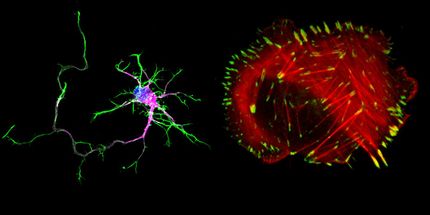Gene mutation alone causes transmissible prion disease
For the first time, Whitehead Institute researchers have shown definitively that mutations associated with prion diseases are sufficient to cause a transmissible neurodegenerative disease. The discovery is reported in Neuron.
Until now, two theories about the role mutations play in prion diseases have been at odds. According to one theory, mutations make carriers more susceptible to prions in the environment. Alternatively, mutations themselves might cause the disease and the spontaneous generation of transmissible prions.
Prions are misfolded versions of a protein called PrP. In its normal form, PrP is expressed in the brain and other neural tissues. But specific events, such as exposure to prions from the environment, can cause PrP to change from its normal shape to that of a prion. Once in the prion shape, the protein can convert other normal PrP proteins to the abnormal shape. As PrP proteins convert to prions, they form long chains that damage brain and nerve cells, causing the neurodegenerative and behavioral symptoms characteristic of prion diseases.
To determine if a mutation in the PrP gene can cause a transmissible prion disease, Walker Jackson, postdoctoral researcher in the lab of Whitehead Member Susan Lindquist, engineered a knock-in mouse expressing a PrP gene carrying the mutation associated with the human prion disease fatal familial insomnia (FFI).
In knock-in experiments, the researcher removes a gene of interest, makes specific changes to it in a test tube, and then places it back in its original place in the genome. In this case, Jackson replaced the mouse PrP gene with an altered version carrying the FFI mutation. This version also carried a sequence from human PrP that prevented the mice from acquiring normal mouse prions that could potentially be in the environment.
"It's more difficult to create a knock-in mouse, instead of randomly integrating the mutated gene into the mouse's genome," says Jackson. "But creating a knock-in like this makes sure the gene is expressed when and where it normally would be. That's the number one reason we think this disease model worked so well, compared to others' experiments."
As adults, the mice exhibited many of the same traits as human FFI patients: reduced activity levels and sleep abnormalities. When Jackson examined the mice's brains, they resembled those of human FFI patients, with prominent damage to the thalamic region of the brain.
After establishing that the mice have the behavioral and pathological characteristics of FFI, Jackson injected diseased brain tissue from the FFI mice into healthy mice. The healthy mice also carried the same human derived barrier as the FFI mice, preventing their infection by normal mouse prions and ensuring that the only prion they could acquire was the one engineered by Jackson. After injection with the affected tissue, the healthy mice exhibited similar symptoms and neuropathology as the mice with the FFI mutation.
The mutated gene engineered by Jackson had created a transmissible prion disease that could not be attributed to any prions in the environment.
"One of the major tenets of the prion hypothesis is that a single amino acid change in PrP, associated with human disease, is sufficient to cause the spontaneous production of infectious material," says Lindquist, who is also a professor of biology at MIT and a Howard Hughes Medical Institute investigator. "Many people have tried and come close. But this is the first time it has been nailed."
Original publication: Walker S. Jackson, Andrew Borkowski, Henryk Faas, Andrew Steele, Oliver King, Nicki Watson, Alan Jasanoff, and Susan Lindquist; "Spontaneous generation of prion infectivity in fatal familial insomnia knock-in mice"; Neuron , August 27, 2009.
Most read news
Topics
Organizations
Other news from the department science

Get the life science industry in your inbox
By submitting this form you agree that LUMITOS AG will send you the newsletter(s) selected above by email. Your data will not be passed on to third parties. Your data will be stored and processed in accordance with our data protection regulations. LUMITOS may contact you by email for the purpose of advertising or market and opinion surveys. You can revoke your consent at any time without giving reasons to LUMITOS AG, Ernst-Augustin-Str. 2, 12489 Berlin, Germany or by e-mail at revoke@lumitos.com with effect for the future. In addition, each email contains a link to unsubscribe from the corresponding newsletter.
Most read news
More news from our other portals
Last viewed contents

Researchers lay groundwork for potential dog-allergy vaccine - Scientists have identified a series of molecular candidates for those parts of dog allergens that cause immune reactions in people
Swedish Orphan Biovitrum and Pharming sign Rhucin distribution agreement
Genzyme to Gain Late-Stage Transplantation Product Candidate























































